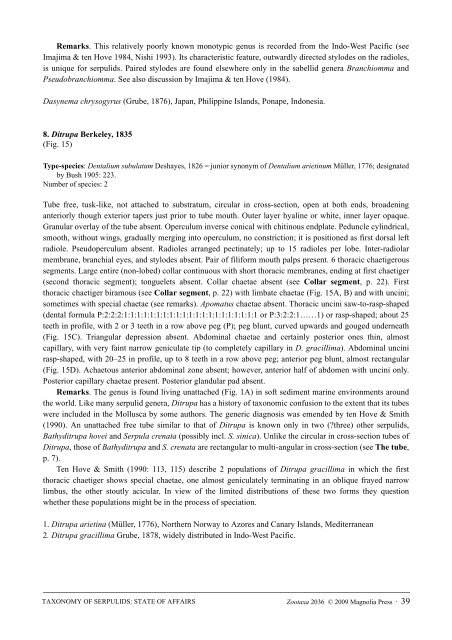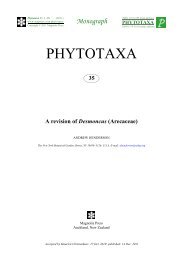Zootaxa, Taxonomy of Serpulidae (Annelida ... - Magnolia Press
Zootaxa, Taxonomy of Serpulidae (Annelida ... - Magnolia Press
Zootaxa, Taxonomy of Serpulidae (Annelida ... - Magnolia Press
Create successful ePaper yourself
Turn your PDF publications into a flip-book with our unique Google optimized e-Paper software.
Remarks. This relatively poorly known monotypic genus is recorded from the Indo-West Pacific (see<br />
Imajima & ten Hove 1984, Nishi 1993). Its characteristic feature, outwardly directed stylodes on the radioles,<br />
is unique for serpulids. Paired stylodes are found elsewhere only in the sabellid genera Branchiomma and<br />
Pseudobranchiomma. See also discussion by Imajima & ten Hove (1984).<br />
Dasynema chrysogyrus (Grube, 1876), Japan, Philippine Islands, Ponape, Indonesia.<br />
8. Ditrupa Berkeley, 1835<br />
(Fig. 15)<br />
Type-species: Dentalium subulatum Deshayes, 1826 = junior synonym <strong>of</strong> Dentalium arietinum Müller, 1776; designated<br />
by Bush 1905: 223.<br />
Number <strong>of</strong> species: 2<br />
Tube free, tusk-like, not attached to substratum, circular in cross-section, open at both ends, broadening<br />
anteriorly though exterior tapers just prior to tube mouth. Outer layer hyaline or white, inner layer opaque.<br />
Granular overlay <strong>of</strong> the tube absent. Operculum inverse conical with chitinous endplate. Peduncle cylindrical,<br />
smooth, without wings, gradually merging into operculum, no constriction; it is positioned as first dorsal left<br />
radiole. Pseudoperculum absent. Radioles arranged pectinately; up to 15 radioles per lobe. Inter-radiolar<br />
membrane, branchial eyes, and stylodes absent. Pair <strong>of</strong> filiform mouth palps present. 6 thoracic chaetigerous<br />
segments. Large entire (non-lobed) collar continuous with short thoracic membranes, ending at first chaetiger<br />
(second thoracic segment); tonguelets absent. Collar chaetae absent (see Collar segment, p. 22). First<br />
thoracic chaetiger biramous (see Collar segment, p. 22) with limbate chaetae (Fig. 15A, B) and with uncini;<br />
sometimes with special chaetae (see remarks). Apomatus chaetae absent. Thoracic uncini saw-to-rasp-shaped<br />
(dental formula P:2:2:2:1:1:1:1:1:1:1:1:1:1:1:1:1:1:1:1:1:1:1:1:1 or P:3:2:2:1……1) or rasp-shaped; about 25<br />
teeth in pr<strong>of</strong>ile, with 2 or 3 teeth in a row above peg (P); peg blunt, curved upwards and gouged underneath<br />
(Fig. 15C). Triangular depression absent. Abdominal chaetae and certainly posterior ones thin, almost<br />
capillary, with very faint narrow geniculate tip (to completely capillary in D. gracillima). Abdominal uncini<br />
rasp-shaped, with 20–25 in pr<strong>of</strong>ile, up to 8 teeth in a row above peg; anterior peg blunt, almost rectangular<br />
(Fig. 15D). Achaetous anterior abdominal zone absent; however, anterior half <strong>of</strong> abdomen with uncini only.<br />
Posterior capillary chaetae present. Posterior glandular pad absent.<br />
Remarks. The genus is found living unattached (Fig. 1A) in s<strong>of</strong>t sediment marine environments around<br />
the world. Like many serpulid genera, Ditrupa has a history <strong>of</strong> taxonomic confusion to the extent that its tubes<br />
were included in the Mollusca by some authors. The generic diagnosis was emended by ten Hove & Smith<br />
(1990). An unattached free tube similar to that <strong>of</strong> Ditrupa is known only in two (?three) other serpulids,<br />
Bathyditrupa hovei and Serpula crenata (possibly incl. S. sinica). Unlike the circular in cross-section tubes <strong>of</strong><br />
Ditrupa, those <strong>of</strong> Bathyditrupa and S. crenata are rectangular to multi-angular in cross-section (see The tube,<br />
p. 7).<br />
Ten Hove & Smith (1990: 113, 115) describe 2 populations <strong>of</strong> Ditrupa gracillima in which the first<br />
thoracic chaetiger shows special chaetae, one almost geniculately terminating in an oblique frayed narrow<br />
limbus, the other stoutly acicular. In view <strong>of</strong> the limited distributions <strong>of</strong> these two forms they question<br />
whether these populations might be in the process <strong>of</strong> speciation.<br />
1. Ditrupa arietina (Müller, 1776), Northern Norway to Azores and Canary Islands, Mediterranean<br />
2. Ditrupa gracillima Grube, 1878, widely distributed in Indo-West Pacific.<br />
TAXONOMY OF SERPULIDS: STATE OF AFFAIRS<br />
<strong>Zootaxa</strong> 2036 © 2009 <strong>Magnolia</strong> <strong>Press</strong> · 39
















